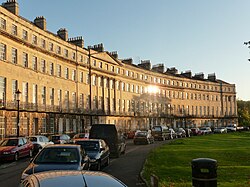Norfolk Crescent, Bath
| Norfolk Crescent | |
|---|---|
 |
|
| Location | Bath, Somerset, England |
| Coordinates | 51°22′57″N 2°22′12″W / 51.38250°N 2.37000°WCoordinates: 51°22′57″N 2°22′12″W / 51.38250°N 2.37000°W |
| Built | c.1792 to c.1822 |
| Architect | John Palmer and John Pinch |
| Architectural style(s) | Georgian |
|
Listed Building – Grade II*
|
|
| Official name: Cumberland House | |
| Designated | 12 June 1950 |
| Reference no. | 443118 |
|
Listed Building – Grade II*
|
|
| Official name: Watchman's Box | |
| Designated | 12 June 1950 |
| Reference no. | 443154 |
Norfolk Crescent in Bath, Somerset, England was built between c.1793 and c.1822 and has been designated as a Grade II* listed building. The original design was by John Palmer, but minor alterations were later made by John Pinch.
The Georgian terrace, which is known as Cumberland House, includes numbers 1 to 7 which have been converted into flats, and numbers 8 to 18 consecutively. Each has five storeys (basement, ground floor, piano nobile, second floor and attic) and the central portion has 6 Ionic pilasters.
There is a green area in front of the crescent that was originally a formal garden for the residents, surrounded by railings. A small circular building in the corner of the gardens is the old watchman's hut, and is also Grade II* listed.
In March 1792 a solicitor named Richard Bowsher took a lease on 5 acres (20,000 m2) of land next to the river Avon at what was then the western edge of the city of Bath. The lease stipulated houses of similar style and quality to those being erected in the nearby New King Street should be built on the land. As with other Bath developers, Bowsher's sub-leased plots of ground to craftsmen, on the condition that they would build houses on them, which would subsequently be let out to wealthy families. Several streets were planned with over 100 houses, the centrepiece being a crescent called Norfolk Place (later changed to Norfolk Crescent). The architect John Palmer was engaged to designed a facade for the buildings.
However, in early 1793 a financial crisis, caused by the Bath Bank crash, brought disaster. Some of the builders went bankrupt and others were reluctant to take on new projects. None of Bowsher's houses were complete, but he had to continue paying rent for the land. Nevertheless, he survived the crash and in the 19th century the development was scaled down to a reduced plan with two main streets, Norfolk Crescent and Nelson Place, and the short Nile Street linking to the Upper Bristol Road to the north. These streets were named after Admiral Nelson, his home county (Norfolk) and his most famous victory to date (the Battle of the Nile, since the name was chosen before the Battle of Trafalgar was fought in 1805). The proposed streets in front of the crescent were abandoned and instead the area was made into a formal garden for the residents of Norfolk Crescent and Nelson Place, with each house paying £2.2 annual rent for their upkeep. At the corner of the railed gardens, where Norfolk Crescent, Nile Street, Great Stanhope Street and Nelson Place meet, a watchman's hut was built. The watchman's hut was built to a classical design inspired by the Choragic Monument of Lysicrates. The renewed scheme also saw a new architect, John Pinch, making some minor alterations to the design.
...
Wikipedia

